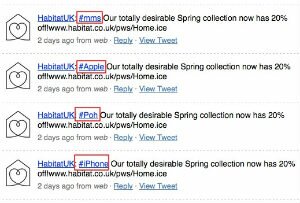The last twelve months have seen companies adopt social media strategies by the truckload, leading to some excellent examples of social media….and some examples of what not to do. There’s been some interesting developments on Twitter in particular, where bad news spreads fast.
So, what have we learnt about social media?
Though shalt not steal
The web has provided a whole new way to crowdsource business ideas and creative processes. But that doesn’t make it a general free-for-all when it comes to words and designs. A writer called Monica Gaudio alerted the social media world to a plagiarism case, where her work was featured in a food magazine without asking for permission. Sadly, it’s a common occurrence, but it’s the response from the editor of the Cooks Source that shocked people.
‘The web is considered “public domain” and you should be happy we just didn’t “lift” your whole article and put someone else’s name on it….. you as a professional should know that the article we used written by you was in very bad need of editing, and is much better now than was originally.’
To make it worse, the editor then went on to say that Monica probably should have paid her, considering the favour she did for her on editing. A further statement on the Facebook page seemed to mock Monica, and boasted that their followers had gone up.
The editor clearly didn’t understand the legalities of taking someone’s work, and clearly didn’t anticipate that followed.
Paperchase also had trouble when Hidden Eloise, an illustrator who sells her designs on Etsy, blogged about how they had stolen one of her designs. Their slow and ineffective response led to a huge amount of bad PR across Twitter and Facebook.
The Lesson
Bloggers have a powerful voice. Befriend them instead of alienating them.
 Respect the power
Respect the power
Nestle unfortunately learnt this lesson the hard way. Already a brand connected with all kinds of PR disasters, the company’s connection to the deforestation in Indonesia was unearthed by Greenpeace, and the message spread like wildfire on Twitter. Since then the brand has been in trouble with various activists on , and continues to struggle with its brand reputation.
The Lesson
Run your business in an unethical or disrespectful manner, and you can expect to be exposed online.
Don’t cut and paste
Tiger Airways made the mistake earlier this year of giving every negative comment a bit of a brush off, along the lines of “You get what you paid for.” This, understandably, only riled commenters up further.
It then got worse. They started deleting any negative comments, and banning users who left them.
Overall, not a great way of communicating with customers and visitors.
The Lesson
Reply to each follower individually, and try to take a negative comment as constructive criticism. It might help your business improve.
Create some rules
Underestimating the social media usage of employees was a mistake Domino’s made at the start of the year. Prior to the success of the Domino’s Foursquare campaign, the company was the victim of a recording made of two of its employees, who were filmed wiping mucas onto sandwiches. Nice.
Domino’s were quick to issue apologies on Facebook and Twitter, and produced an apology video on YouTube
Great response, and a lesson learned about how employees have to be careful on social media too.
Vodafone had a similar problem at the start of the year, when an employee posted an obscene remark on their Twitter feed. Like Domino’s, they were quick to respond and suspended the employee immediately.
The Lesson
Put together a social media policy pronto. There’s a great list of social media policies over on Social Media Today.
Don’t blame the intern
 Habitat came a cropper back in 2009, when they misused the in their tweets. Hashtags are terms or words added to tweets, like #HarryPotter or #RoyalWedding, that allow people to search for all the discussions related to that topic.
Habitat came a cropper back in 2009, when they misused the in their tweets. Hashtags are terms or words added to tweets, like #HarryPotter or #RoyalWedding, that allow people to search for all the discussions related to that topic.
The company inserted popular hashtags into the start of all their tweets, in order to raise the profile of their content. The practice had already begun to irritate followers, who called it ‘spamming’, but the use of a tag for the Iranian election really angered people. A backlash occurred, with Twitter users retweeting and criticising the move. Explain this more – link to what a hashtag is. Imagine you’re explaining to someone who doesn’t use Twitter.
The Lesson
By patronising followers with blatant advertising and the misuse of hashtags, the company was left picking up the pieces of a damaged brand name. Worse still, the company blamed the intern! If you’ve got a social media policy in place (see above), this sort of thing should never happen, but if it does blaming the intern is a terrible excuse — not only does it make an unpaid, untrained work experience person the scapegoat, it doesn’t say a lot about how seriously you take your social media strategy.
What lessons have you learnt about social media this year?




 We are thrilled that Don Tapscott, author of the international bestseller, Wikinomics, is going to be speaking with members of the
We are thrilled that Don Tapscott, author of the international bestseller, Wikinomics, is going to be speaking with members of the  An extraordinary book…should be required reading for all who want to create positive change for institutions and organizations.” Linda Lorimer, Vice President, Yale University
An extraordinary book…should be required reading for all who want to create positive change for institutions and organizations.” Linda Lorimer, Vice President, Yale University


 “For a company operating across more than 50 countries, with 42 million customers, social media present both a major opportunity for greater engagement and customer warmth and a threat to be managed. It's Open has provided invaluable insight and assistance as we work to deal with this new and challenging field.”
“For a company operating across more than 50 countries, with 42 million customers, social media present both a major opportunity for greater engagement and customer warmth and a threat to be managed. It's Open has provided invaluable insight and assistance as we work to deal with this new and challenging field.”